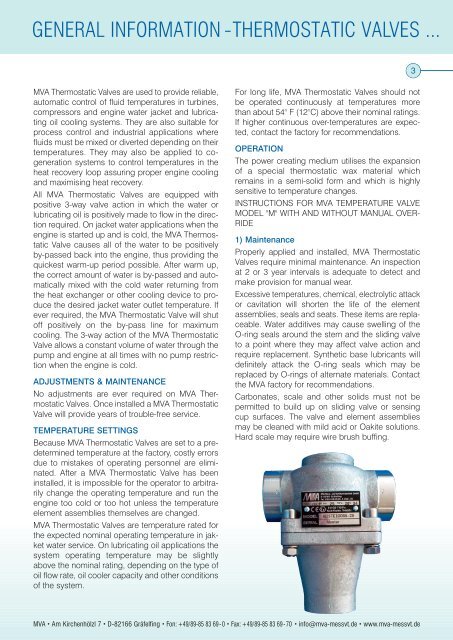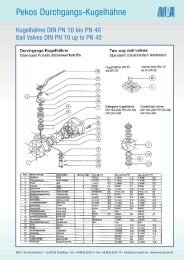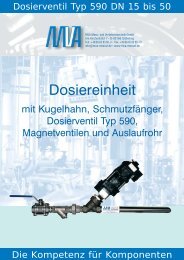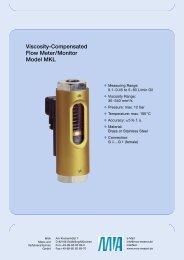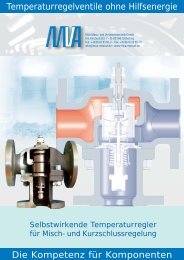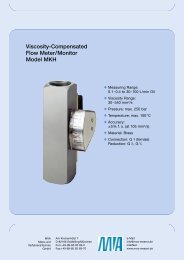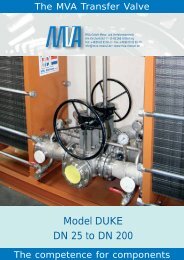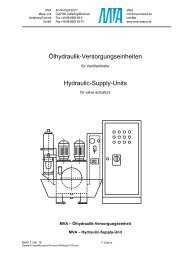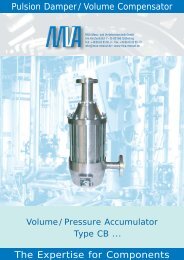Mcontroler English - MVA Mess
Mcontroler English - MVA Mess
Mcontroler English - MVA Mess
Create successful ePaper yourself
Turn your PDF publications into a flip-book with our unique Google optimized e-Paper software.
GENERAL INFORMATION -THERMOSTATIC VALVES ...<br />
<strong>MVA</strong> Thermostatic Valves are used to provide reliable,<br />
automatic control of fluid temperatures in turbines,<br />
compressors and engine water jacket and lubricating<br />
oil cooling systems. They are also suitable for<br />
process control and industrial applications where<br />
fluids must be mixed or diverted depending on their<br />
temperatures. They may also be applied to cogeneration<br />
systems to control temperatures in the<br />
heat recovery loop assuring proper engine cooling<br />
and maximising heat recovery.<br />
All <strong>MVA</strong> Thermostatic Valves are equipped with<br />
positive 3-way valve action in which the water or<br />
lubricating oil is positively made to flow in the direction<br />
required. On jacket water applications when the<br />
engine is started up and is cold, the <strong>MVA</strong> Thermostatic<br />
Valve causes all of the water to be positively<br />
by-passed back into the engine, thus providing the<br />
quickest warm-up period possible. After warm up,<br />
the correct amount of water is by-passed and automatically<br />
mixed with the cold water returning from<br />
the heat exchanger or other cooling device to produce<br />
the desired jacket water outlet temperature. If<br />
ever required, the <strong>MVA</strong> Thermostatic Valve will shut<br />
off positively on the by-pass line for maximum<br />
cooling. The 3-way action of the <strong>MVA</strong> Thermostatic<br />
Valve allows a constant volume of water through the<br />
pump and engine at all times with no pump restriction<br />
when the engine is cold.<br />
ADJUSTMENTS & MAINTENANCE<br />
No adjustments are ever required on <strong>MVA</strong> Thermostatic<br />
Valves. Once installed a <strong>MVA</strong> Thermostatic<br />
Valve will provide years of trouble-free service.<br />
TEMPERATURE SETTINGS<br />
Because <strong>MVA</strong> Thermostatic Valves are set to a predetermined<br />
temperature at the factory, costly errors<br />
due to mistakes of operating personnel are eliminated.<br />
After a <strong>MVA</strong> Thermostatic Valve has been<br />
installed, it is impossible for the operator to arbitrarily<br />
change the operating temperature and run the<br />
engine too cold or too hot unless the temperature<br />
element assemblies themselves are changed.<br />
<strong>MVA</strong> Thermostatic Valves are temperature rated for<br />
the expected nominal operating temperature in jakket<br />
water service. On lubricating oil applications the<br />
system operating temperature may be slightly<br />
above the nominal rating, depending on the type of<br />
oil flow rate, oil cooler capacity and other conditions<br />
of the system.<br />
For long life, <strong>MVA</strong> Thermostatic Valves should not<br />
be operated continuously at temperatures more<br />
than about 54° F (12°C) above their nominal ratings.<br />
If higher continuous over-temperatures are expected,<br />
contact the factory for recommendations.<br />
OPERATION<br />
The power creating medium utilises the expansion<br />
of a special thermostatic wax material which<br />
remains in a semi-solid form and which is highly<br />
sensitive to temperature changes.<br />
INSTRUCTIONS FOR <strong>MVA</strong> TEMPERATURE VALVE<br />
MODEL "M" WITH AND WITHOUT MANUAL OVER-<br />
RIDE<br />
1) Maintenance<br />
Properly applied and installed, <strong>MVA</strong> Thermostatic<br />
Valves require minimal maintenance. An inspection<br />
at 2 or 3 year intervals is adequate to detect and<br />
make provision for manual wear.<br />
Excessive temperatures, chemical, electrolytic attack<br />
or cavitation will shorten the life of the element<br />
assemblies, seals and seats. These items are replaceable.<br />
Water additives may cause swelling of the<br />
O-ring seals around the stem and the sliding valve<br />
to a point where they may affect valve action and<br />
require replacement. Synthetic base lubricants will<br />
definitely attack the O-ring seals which may be<br />
replaced by O-rings of alternate materials. Contact<br />
the <strong>MVA</strong> factory for recommendations.<br />
Carbonates, scale and other solids must not be<br />
permitted to build up on sliding valve or sensing<br />
cup surfaces. The valve and element assemblies<br />
may be cleaned with mild acid or Oakite solutions.<br />
Hard scale may require wire brush buffing.<br />
<strong>MVA</strong> • Am Kirchenhölzl 7 • D-82166 Gräfelfing • Fon: +49/89-85 83 69 -0 • Fax: +49/89-85 83 69 -70 • info@mva-messvt.de • www.mva-messvt.de<br />
3


